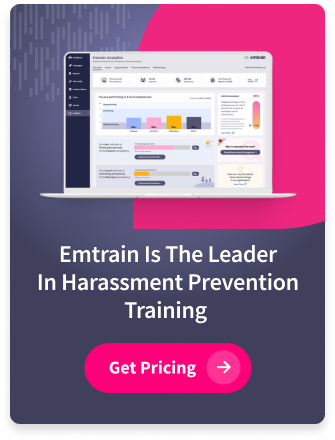Our analysis of 48 million employee sentiment responses reveals a workplace in tension: organizations achieved a remarkable 25% reduction in unhealthy accountability behaviors and strengthened compliance across every major area—yet simultaneously experienced significant declines in psychological safety, collaboration, and interpersonal dynamics.
Employees are -9.89% more likely to encounter conflict driven by political and social views. They’re -4.13% less likely to seek out diverse perspectives and -3.38% more hesitant to share ideas with their teams. Meanwhile, managers have become +7.60% more self-aware about their personal impact but -2.69% less capable of resolving team conflict.
This dual reality—strengthening compliance infrastructure alongside declining interpersonal effectiveness—defines the challenge for workplace culture in 2026. The good news? Organizations have proven they can shift culture systematically. The compliance gains demonstrate that targeted investment drives measurable behavioral change.
Here are three strategic actions to improve workplace culture that deserve prioritization, especially in organizations doing business transformations and major AI initiatives in 2026.
Action 1: Invest in Leadership Development That Closes the Skills Gap
Today’s managers face an unprecedented paradox: they’re becoming more self-aware (+2.80% improvement in adjusting to constructive criticism) while losing the ability to manage team dynamics (-2.69% decline in conflict resolution). This isn’t a contradiction—it’s a mismatch between personal development and the skills this moment demands.
What effective leadership development requires:
Not generic leadership principles, but targeted training in:
- Conflict resolution: Practical frameworks for facilitating difficult conversations between team members, mediating without taking sides, and knowing when to escalate versus handle independently
- Power dynamics: Understanding how positional authority shapes interactions and learning to use influence intentionally to create opportunities rather than fear
- Change management: Coaching employees through AI anxiety and role uncertainty while maintaining productivity amid ambiguity
- Empathetic leadership: Reading emotional dynamics, balancing empathy with accountability, and responding to declining interpersonal connection
Critical addition: Measurement matters
Training initiatives without measurement is aspiration without accountability. Senior leaders need quantifiable ways to assess their division’s effectiveness in resolving conflicts, managing power influence, and fostering psychological safety.
Why now: Organizations reducing management layers leave remaining managers facing unprecedented complexity. Development investment isn’t optional—it’s the difference between transformation success and expensive failure.
Action 2: Monitor and Manage Organizational Risk Proactively
The 25% reduction in unhealthy accountability behaviors demonstrates what systematic compliance approaches achieve. Organizations saw substantial improvements:
- +4.55% reduced tolerance for bribery risk shortcuts
- +2.53% increased willingness to address risky digital behavior
- +2.20% more likely to report a concern
These gains prove that structured investment—training, reporting mechanisms, remediation processes—shifts behavioral norms measurably.
The 2026 evolution: From reactive to predictive
Most HR compliance programs focus on responding to incidents. The next evolution is proactive monitoring of leading indicators that predict problems before they become reportable incidents.
What proactive compliance entails:
- Continuous Behavioral Monitoring: Measure compliance culture indicators, enabling real-time visibility into risk areas.
- Predictive Analytics: Identify patterns that precede compliance failures—declining speak-up confidence in specific business units, erosion of accountability under quarterly pressure, etc.
- Targeted Interventions: Enable compliance managers to work tactically, focusing on departments or locations where data shows policies are likely to be ignored and employees are reluctant to report concerns.
- Integration with Risk Management
Connect behavioral compliance data with operational risk frameworks, providing holistic visibility for executive decision-making and independent oversight from Board Audit Committees. - Structural Reinforcement
Address the perception gap by visibly investing in sustainable compliance infrastructure—adequate staffing, technology integration, and clear escalation pathways.
When these indicators decline, deploy targeted interventions—additional training, leadership coaching, process refinement—before issues escalate to regulatory violations, legal costs, or reputational damage.
Foundation requirement: Empower managers with training that teaches regulatory requirements, and developmental competency in recognizing early warning signs, knowing when situations require escalation, and creating environments where employees feel safe raising concerns.
Action 3: Strengthen Psychological Safety for Innovation
Innovation isn’t stalling because organizations lack good ideas—it’s stalling because good ideas stay silent. Employees are more hesitant to share ideas and feedback (-3.38%), less likely to create opportunities for others (-8.71%) and less convinced that multiple perspectives improve decisions (-1.81%.) The conditions enabling innovation are eroding precisely when transformation demands creativity.
What rebuilding psychological safety requires:
Structured channels, not just open doors: specific mechanisms: pre-mortems that invite challenge before finalizing decisions, devil’s advocate roles that normalize dissent, anonymous input channels, and regular forums with explicit non-judgment norms.
Visible rewards for productive dissent: Publicly celebrate people who respectfully challenged flawed decisions and improved outcomes. Make heroes of those who contribute through constructive disagreement, not just efficient execution.
Leadership vulnerability from the top: When executives only project confidence, everyone else mirrors that behavior. Leaders must admit mistakes, ask questions without known answers, and invite challenge.
Address fear directly: Employees worry about AI replacing their roles. Provide clarity where possible. Where clarity isn’t possible, offer transparency about processes and support for navigating uncertainty. People handle hard truths better than being kept in the dark.
The stakes are high. Organizations that thrive won’t be those with the best AI strategy—they’ll be those creating conditions where humans do what AI cannot: think creatively, challenge assumptions, and collaborate across differences to generate novel solutions.
The Reality: People Drive Transformation
Employees worry about being replaced by AI, and that drives the self-protective behaviors we observe—less openness, reduced collaboration, increased hesitancy to speak up. This existential anxiety creates survival mode thinking precisely when organizations need creative problem-solving.
Meanwhile, managers lack the skills required to lead through this uncertainty. They’re self-aware but struggle with team conflict. They’re expected to coach through change while lacking effective frameworks. Managers are tasked with driving innovation while psychological safety collapses.
This is 2026’s central challenge: organizations need human leadership to navigate technological transformation, but those leaders are overloaded, underskilled, and operating in cultural conditions undermining effectiveness.
The Choice: Intentional Action or Continued Decline
Workplace culture became measurably less healthy in 2025. The potential for innovation roadblocks, stifled ideas, and withheld critical feedback is real. But so is the potential for reversal.
These three strategic actions to transform workplace culture represent achievable, proven strategies:
- Invest in leadership development with specific skills training and measurement systems that ensure effectiveness.
- Monitor and manage organizational risk proactively by tracking leading indicators that predict problems before they materialize.
- Strengthen psychological safety through structured channels, visible recognition, leadership modeling, and direct acknowledgment of employee concerns.
Organizations taking these actions will build competitive advantage through their people. Those that don’t will watch the gap between transformation ambitions and cultural reality continue widening.
Today’s landscape demands new leadership skills and proactive risk management.
Organizations that thrive in 2026 will act decisively. Don’t wait for culture to improve on its own—it won’t.
How Emtrain can help you take action:
- Assessment tools to identify specific skill gaps hampering employees and managers
- Proactive risk monitoring systems for HR & People risks and Business Compliance risks
- Training programs that build sustainable capability in modern skills
Questions? We’re here to help. Reach out to discuss how these strategies can be tailored to your organization.








